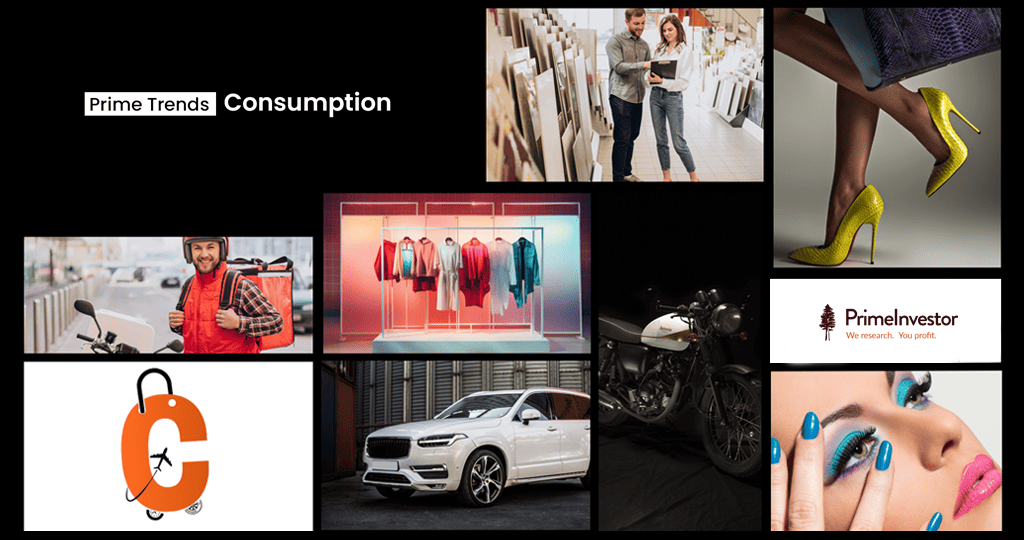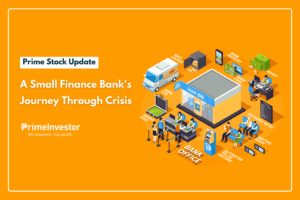What does your typical day look like? You wake up, have a cup of coffee or tea. There’s breakfast to have, lunch to prepare, laundry to do, spend the day at work, with a well-earned sleep at the end.
But that’s just the routine! There’s so much more you do in the day – stepping out to a nice lunch with colleagues, browsing through Amazon or Flipkart and filling up that shopping basket or then going out to the mall and doing the same. Swiggy or Zomato come in handy when you’re too tired to get dinner ready. Your commute is made bearable listening to music or podcasts on your phone or the perfect car sound system. Weekends are spent at the movies, at dinner maybe, or lazing at home with your big-screen TV. Or perhaps driving down in your comfortable SUV to a short weekend getaway once in a while!
This is your story. This is the NEW consumption story. Aside from the routine goods we all consume to live and survive, life has now become more about aspirations and experiences. Call it the YOLO effect or upgrading your lifestyle, you are now revving up the New Consumption story in India.

Our newest smallcase portfolio – Prime Trends – Consumption is precisely built on this consumption theme. Broadly, the following four factors form the basis for our investment thesis:
- Discretionary spending pick-up: The general thesis is that the average income levels of the population has crossed the threshold that takes care of the basics and incremental income will now go towards discretionary consumption.
- State-wise trends indicate an acceleration in spends across the spectrum: Some of the more developed states, which have crossed well beyond the national per-capita average, have become the bedrock of modern retail and discretionary consumption. Meanwhile, currently poorer states can see consumption picking up as they progress in development thanks to improved infrastructure, shift towards manufacturing and higher labour force participation.
- Growing middle-class to spur aspirational spending: A World Economic Forum study says that the number of middle-income households is likely to increase from 21% of population in 2018 to just over 40% of the population by 2030. Easier access to credit and social media, along with e-commerce, have also become enablers of consumption. All point to a healthy growth rate, far higher than nominal growth rate, for companies that can successfully address the growing consumption needs.
- Scope in individual regions: The large size of our economy and the economic output of each geography offers scalable opportunities for businesses. It isn’t necessary for a country-wide presence for companies to scale up; the sheer size of each region offers ample scope even for regional players.
So, if your spending is going to charge the economy and the consumption theme, there is a way to also benefit from it!
Prime Trends – Consumption smallcase by PrimeInvestor
Here’s a detailed thesis on the Prime Trends – Consumption smallcase.
Consumption drivers
Consumption is the core strength of India’s GDP as 2/3rd is driven by it. While we are fast approaching the $4 trillion GDP size and the 4th largest economy in the world, our per capita GDP is still around $2,500 and is ranked far lower in the world order. While some of the comparisons may not make sense, the consensus is that we should head far higher from this level in the coming decade.
Our economy is growing at a nominal GDP growth rate of 10-11% per annum and so is the per capita GDP. The general thesis is that the average income levels of the population has crossed the threshold ($2,000) to take care of the “roti-kapda-makaan” and incremental income will go towards discretionary consumption.
To put this in perspective, the run up to the current $3.5 trillion saw the take-off in discretionary consumption, financialization of savings and boom in services exports. In the listed universe, consumption sectors expanded from FMCG to fashion retail, footwear, quick service restaurants, packaged foods, malls & multiplexes, hotels, travel agents, car dealerships and so on.
The next $3.5 trillion can therefore see further acceleration in discretionary consumption. Growing income levels can propel premium consumption, while the shift in labour pool from agriculture to manufacturing can deepen the consumption pool.
A deeper look at the economy gives some interesting insights into the consumption landscape and the growth ahead.
- India is a sum of different States: Each state is not uniform in its growth, income distribution, and demand. The average per-capita GDP of $2,500, therefore, does not show the real picture in consumption trends. Some States are beyond $3,200 per capita, far ahead of national average. These States, predominantly comprising the West & South, have become the bedrock of modern retail and discretionary consumption. Modern industries like IT services and automobiles, higher women labour force, inward remittances, and so on are acting as the key drivers of consumption. These States comprise just over a third of the total population and the inflection point beyond which buying habits tilt towards discretionary spends has already set in a decade ago.
- Less-developed states can add to consumption as they develop: There are some large States with per capita GDP below the national average, as well as a few large States with per capita GDP at less than half of national average. This latter set of states is home to a third of population. But they are also growing, and in the next few years, those large States will also cross the $2,000 threshold. A combination of urban migration, infrastructure improvement, manufacturing sector employment and women participation in labour force can act as significant drivers of per capita GDP growth of these poorer States in the coming years and could keep deepening the consumption pool.
- Middle income demand boom: A World Economic Forum study says that the number of middle-income households is likely to increase from 21% of population in 2018 to just over 40% of the population by 2030. This points to a high single digit CAGR in consuming population – and this combined with high a single dight CAGR in income growth (equal to nominal GDP growth) can act as a key driver of consumption. This indicates that companies that can successfully capture the trends in this rising demand can clock growth far higher than nominal growth rate.
- Credit, e-commerce and social media enablers: These three factors are strong enablers of consumption by democratising purchasing power, distribution reach and information access. This has enabled companies to service “developed rural” population without the need for physical channels. Start-ups in new consumer categories have created successful and scalable enterprises using digital channels alone as these enablers have acted in tandem.
- Scope in size: The large size of our economy and the economic output of each geography offers scalable opportunities for businesses. To put this in perspective, each geography could be a trillion dollar in size over the next few years (South, West, North & central or East & central). It isn’t necessary for a country-wide presence for companies to scale up; the sheer size of each region offers ample scope for regional players, and their ability to cater to regional tastes and preferences hold them in good stead.
The Prime Trends – Consumption smallcase
We believe that the four factors above indicate a long-term sustained growth in consumption. Discretionary spending is driven by a shift to premiumisation across categories led by aspirations, improved lifestyles, and higher incomes and a take off in luxury spending. Urban consumers have been relatively more insulated from income impacts due to Covid and have displayed a strong consumption trend – SUV sales reaching 50% of all passenger cars sold in the country and urban real estate demand crossing sales of prior year in first half of current year are some indicators of the strength in urban spending.
However, our Prime Trends – Consumption smallcase is not intended to cover every segment related to consumption, which are several. In our view, it is important to follow trends in incremental consumer spending to successfully ride on the consumption theme. We have identified 3 such pockets of opportunities:
#1 Demand shift
High-growth opportunities lie more in:
- Categories that capture the shift from mass to premium: Companies here can grow from deeper penetration in both online and offline channels, market share gains, and growth in the consumer base.
- Categories in the premium & luxury segments: High growth comes from the nascent stage of these categories, and demand will be driven by the rising urban middle-income consumer segment
For example, companies such as Metro Brands, United Spirits, Titan all capture the rise in aspirational demand and changing lifestyles. Those such as Marico are actively adding product lines to cater to the consumer shift to wellness, while those such as Arvind Fashions combine the shift from mass to premium and premium trends.
#2 Proxy plays
Apart from direct consumer plays that meet discretionary spending, we also look for proxy plays in segments where direct opportunities are limited or proxies make more sense from a financial performance point of view. For example, travel, e-commerce and consumer electronics are areas where the listed space provides limited stock opportunities, but there are proxies to these sectors that are profitable with healthy return on capital.
#3 Emerging opportunities
Two other trends that are emerging and could serve to improve opportunities in the listed space include:
- The rise of domestic brands in categories like electronics, e-commerce, food, fashion, beauty, and wellness where several may be listed over the next few years.
- Consolidation in food and fashion as start-ups facing scalability issues are finding homes in listed FMCG and fashion companies. This is trend is already taking shape, with companies such as Aditya Birla Fashion or Marico acquiring brands.
Therefore, our Prime Trends – Consumption smallcase looks to tap opportunities arising from discretionary consumption growth in the long-term, thereby playing the $3.5 – $7 trillion GDP journey over next few years.
The return driver for our Consumption smallcase will come from investing in those sectors and companies where the growth will be higher than the overall nominal GDP growth rate.
For the Prime Trends – Consumption smallcase, we will follow a bottom-up strategy to pick stocks. Broadly, we look for the following factors:
- Established business models
- Strong brand recall
- Ability to undertake category expansion
- Deeper penetration and make use of e-commerce channels to drive penetration in categories where it is possible.
However, this list still is a motley group, with some stocks having strong established business models, a few which are emerging, and those that are in growing but nascent businesses. Therefore, to balance risk and return, we have structured Prime Trends – Consumption as follows:
Bucket 1 – Comprises stocks with already established business models and market cap leaders in their categories currently. We are looking for market returns while offering downside protection in an adverse market environment from this bucket. This bucket will have the highest portfolio weight.
Bucket 2 – Comprises stocks with emerging business models that have potential to grow bigger either in a niche category or through category expansions and acquisitions in the long term. We are primarily looking at this basket for higher returns and enable alpha generation in the portfolio.
Bucket 3 – Comprises stocks with emerging businesses that are yet to establish visibility on their business model and growth. These could be high potential businesses, but their outcomes are not certain. Meanwhile, some of these may turn out to be big winners if their business models evolve well.
The above factors point to long-term growth in consumer demand, and in our view returns will come more in companies that capture the shift in spending habits rather than all companies that relate to consumer spending.
Why this theme now
Currently, though, stocks and sectors relating to the consumer theme are not raging ahead. For example, FMCG companies have seen a slowing of revenue growth in the past couple of quarters as the effect of price hikes faded. Several fashion players have been hit by a weak demand environment and with sedate growth in the past two quarters. There still are pockets of strong performance, too, with premium car and 2-wheeler sales or jewellery sales charging ahead and hotel occupancies soaring.
It’s also important to note that the Covid and post-Covid periods have caused fluctuations in the demand (and input costs) environment and this is reflecting in quarterly earnings numbers. Growth can, going forward, become more normalised as these fluctuations get evened out. In our view, all this emphasises the need to follow specific consumer spending shifts.
The less-than-expected earnings figures have also helped bring in correction in several stocks, placing them at better valuations for fresh entries. Therefore, the timing to enter a longer-term theme such as consumption now is quite conducive. If we see that this window of timing opportunity is closing, we may decide to pause new subscriptions in the Prime Trends – Consumption smallcase.
These are the reasons we have picked up consumption as a theme for our new Prime Trends smallcase. So, while you spend, why not also earn!
Prime Trends – Consumption smallcase by PrimeInvestor
Some FAQs on this smallcase
- How is this Prime Trends – Consumption smallcase different from a consumption theme mutual fund?
Through this smallcase, we are looking to play the long runway ahead for discretionary consumption in a market cap agnostic way through a concentrated portfolio of 10-15 stocks. The focus is on discretionary consumption and hence our bias is outside of heavy weight sectors like FMCG and Autos that form half of the consumption index and consumption based thematic funds.
A sharper focus on the theme and a concentrated portfolio differentiates our smallcase from thematic funds.
- Should you invest in lumpsum or through SIP?
In general, for any stock investing including smallcase, we recommend lumpsum but in phases. An initial sum followed by additional sums either on correction or when we add more stocks to the portfolio should be the approach. So, a 50-60% allocated amount as lumpsum and remaining in phases would be a good approach for this portfolio.
- Should you own this fund if you have a Consumption fund?
There are 2 factors here. One is the portfolio allocation call that you need to take and second the overlap of this portfolio with a Consumption Fund. If you already have plenty of exposure to Consumption (say over 10%) through the Consumption smallcase or direct stocks, then you need to know that adding a smallcase will further increase your exposure to the consumption theme. On the theme itself, as mentioned in point 1 above, Consumption funds and indices focus more on traditional staples consumption. This smallcase, on the other hand, focuses more on discretionary spending – on lifestyle upgrades, luxury purchases, travel, fashion etc. We therefore anticipate very little overlap with the existing mutual funds.
- What is a smallcase? Is this portfolio management service?
A smallcase is just a basket of stocks that you buy and maintain yourself, taking the research inputs we give and powered by the convenience of smallcase automation (in tie-up with your broker). Our role is restricted to the research we provide. We are not a PMS service. Please learn more about what is a smallcase here.
- Will your broker be able to execute smallcase orders?
Smallcase is tied with a good number of larger brokers. Please check if your broker is tied with smallcase to help execute your smallcase portfolio and rebalancing seamlessly. The list of brokers tied with smallcase is given here.
- What is the cost involved in buying a PrimeInvestor smallcase portfolio?
On the research side, you will be paying PrimeInvestor a fee as mentioned on the smallcase portfolio page. On your brokerage platform, you will incur brokerage cost, securities transaction tax (STT) and demat charges, similar to buying and selling of any stock. If you are a PrimeInvestor subscriber, you also get hefty discounts at the time of this launch.
If you have more queries refer to the FAQ section in our smallcase page or write to us.




10 thoughts on “Prime Trends – Consumption: A Comprehensive Guide”
Its not available for NRIs on HDFC Securities?
There are only a few brokers who have made smallcases available to NRIs. If your broker does not list smallcases, then you won’t be able to invest in these. As far as we know, HDFC Sec does not have smallcases for NRIs. – thanks, Bhavana
Is this available as a portfolio on HDFC Securities — or do I need to invest in individual stocks at the recommended quantity and price? please info
It is a stock portfolio; if you subscribe to the portfolio through smallcase, it will take care of the calculation to buy/sell the right number of stocks to invest your money according to the portfolio weights. The trades are executed through your broker. Please read the FAQ section in the blog above for more info, and you can visit the smallcase help page here as well: https://help.smallcase.com/en/. – thanks, Bhavana
what is the recommended mode of investment in this small case? lumpsump or SIP?
Lumpsum but deployed in phases. Not SIPs. thanks, Vidya
Is the investment should be done in SIP or lumpsun, it was not mentioned in the article ? can you clarify this?
In lumpsum but in phases. Deploy 50-60% roughly and set aside some. We will clarify it in the blog. Thanks for pointing out. Vidya
Hi,
I do not understand the process of investment. Who decides the stocks and the portfolio.
How it is done. ? How I will know details of stocks, investments, return etc.
Please clarify on the above,
Bala
Smallcase is a platform where you can invest in stock/ETF portfolios of different managers. A smallcase is a basket of stocks/ETFs in a specified weighting scheme that reflects a certain objective (ideas, themes, strategies), backed by the research of the smallcase manager. Please go here to know more about smallcase. The stocks or weights in the portfolio are changed (called rebalancing) from time to time by the smallcase manager. When you subscribe to a smallcase, you will see the portfolio details, have access to rebalancing updates etc. The process of calculating number of stocks to buy/sell etc is calculated by smallcase and execution is done through your broker.
Smallcases may be free (that is, you can see the stocks/ETFs in the portfolio, get rebalancing updates without any subscription fee) or require a subscription payment to access the portfolio stocks/ETFs & get & execute rebalancing .
Prime Trends – Consumption is a smallcase that we have launched. We decide the stocks & weights. You need to subscribe to this smallcase if you want to invest in this portfolio. smallcase subscriptions are separate from PrimeInvestor subscriptions. – thanks, Bhavana
Comments are closed.